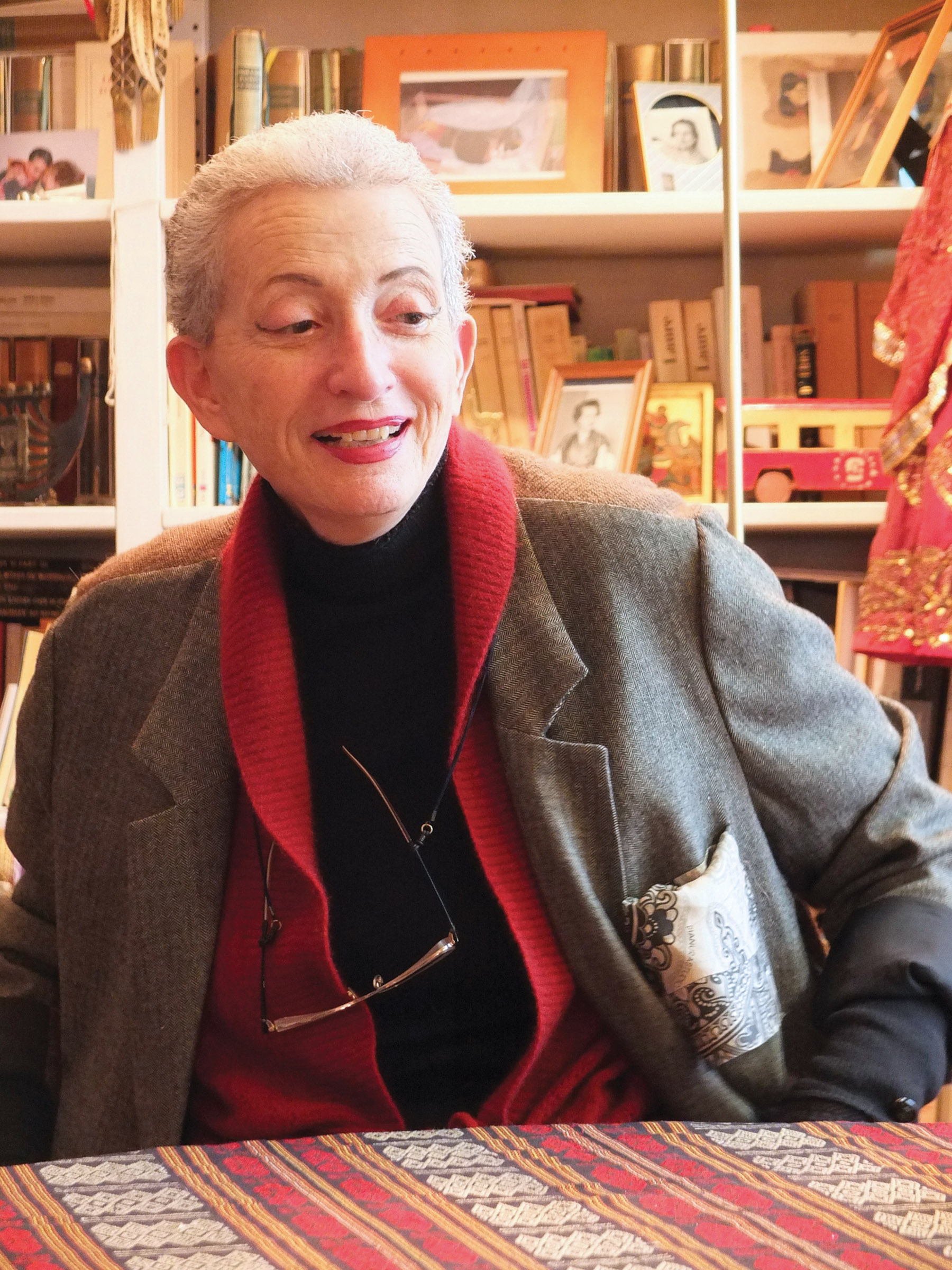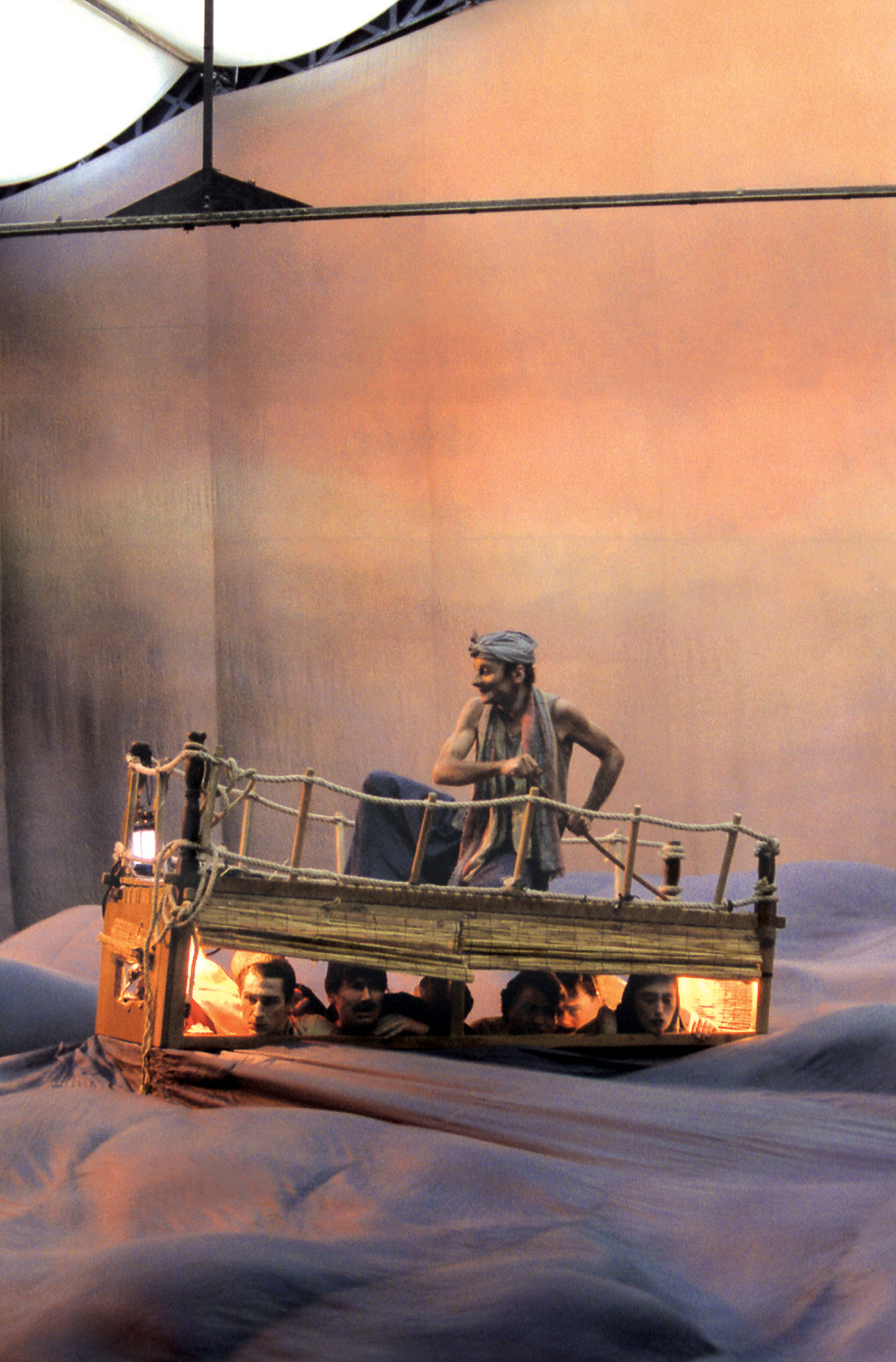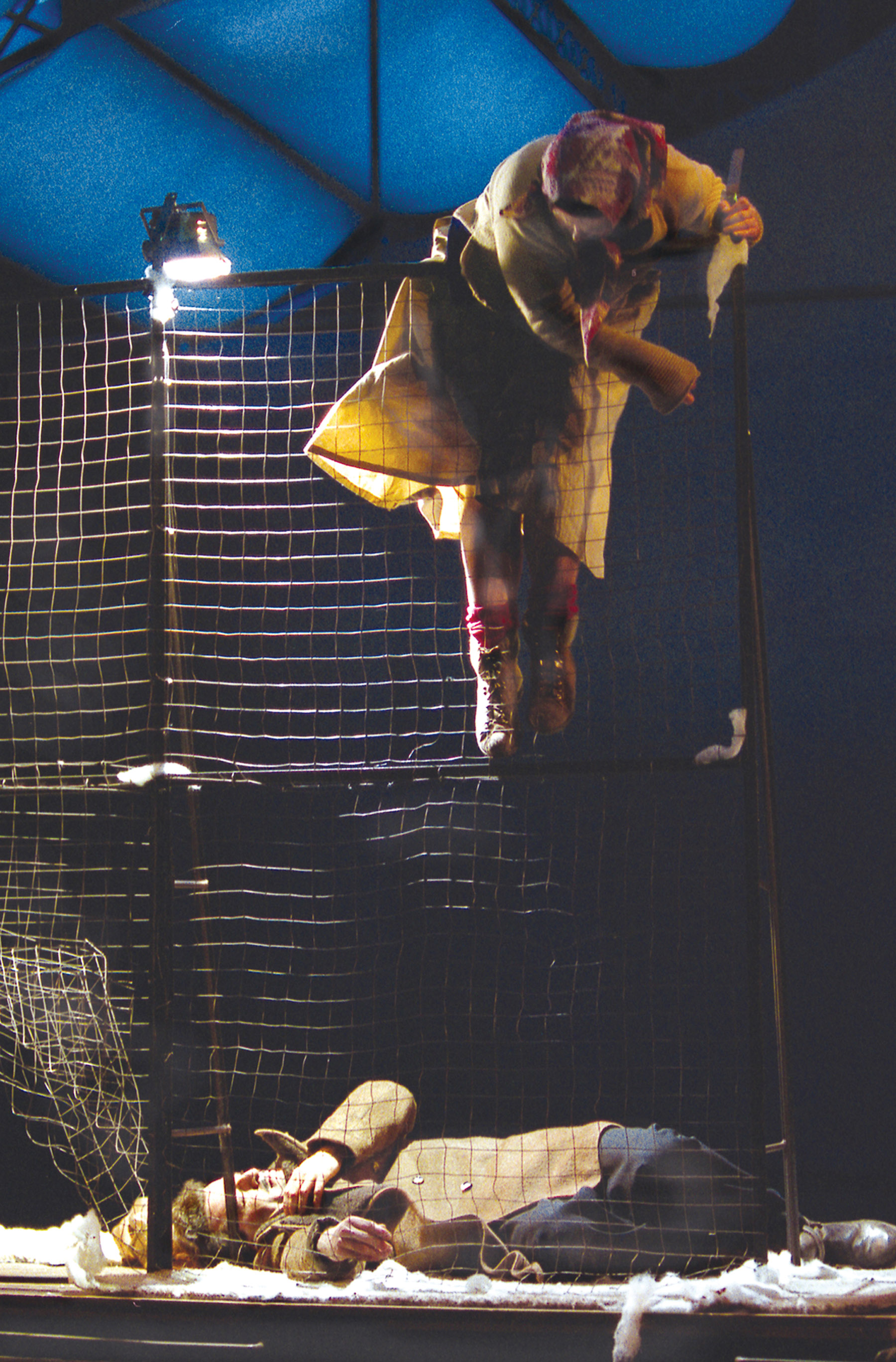Hélène Cixous’s “Notre Spectacle” (Our Performance) is a short text originally written for the program of Le Dernier Caravansérail (Odyssées) (The Last Caravan Stop [Odysseys]), a play written collectively by the French philosopher Cixous and the Théâtre du Soleil in Paris in 2003. Cixous is a long-term collaborator of the Théâtre du Soleil and its director, Ariane Mnouchkine. Since the early 1980s, she has written works for and with them, including L’Histoire terrible mais inachevée de Norodom Sihanouk, roi du Cambodge (The Terrible But Unfinished Story of Norodom Sihanouk, King of Cambodia) in 1985 and Tambours sur la digue (Drums on the Dam) in 1999. In these plays, as in Le Dernier Caravansérail, Cixous and the Théâtre du Soleil are committed to political story-telling through episodic, large-scale spectacles with large casts that place the audience member squarely in the middle of the day-to-day experiences of those under the stresses of colonialism, persecution, and/or statelessness. What is impressive about the Théâtre du Soleil is their ability to entertain and marvel their audience while maintaining an empathic, non-exploitative, and non-didactic relation to the subjects of their work. No easy balance.

Hélène Cixous, December 2012. Photo: Kevin Kane.
As a collective, the Théâtre du Soleil has never produced a manifesto. But its egalitarian principles and its radical commitment to collaboration radiate through Cixous’s text. Structured as a series of questions, “Notre Spectacle” demands both ethical reflection and action from artists collaborating with someone other than themselves: across the boundaries of difference, language, and power.
Questions of ethics in practice continue to be vital to artists, as many of us are working in collaborative or collective ways, either openly in the sphere of participatory artwork or “social practice” or privately in the space of our own studios with large-scale production teams whose identities are not disclosed in benefit of a central author. Collaboration itself is not a new phenomenon, but the terms under which collaborative work is accomplished are reframed by every generation in philosophical, legal, and financial terms. What is unusual and relevant about Cixous is that she is the rare theorist who also practices successfully as an artist and these practices are marked both by her ethics and her action-oriented stance.

Théâtre du Soleil, Le Dernier Caravansérail (Odyssées): Origines et destins, “Sur la route de l’Australie,” Duccio Bellugi, Sébastien Brottet-Michel, Sava Lolov, Delphine Cottu, Serge Nicolaï, Vincent Mangado, and Dominique Jambert, 2003. © Michèle Laurent.
Le Dernier Caravansérail gathers the stories of escape and unimaginable danger faced by migrants from the world over—Iran, Iraq, Afghanistan, Russia, Serbia—in search of better lives elsewhere. These “elsewheres,” such as Australia, France, and Great Britain, often materialize as places of great misfortune, as those seeking a better life often end up in political no-man’s lands, such as refugee camps and prisons. The stories presented in Le Dernier Caravansérail are based on interviews conducted by Cixous and other members of the Théâtre du Soleil with refugees across the world. Some are the stories of those living at the theater itself, which serves as a safe-haven and a place of employment and community.
Le Dernier Caravansérail was originally presented as a two-part, six-hour play, with a break halfway through for a meal cooked and served by the actors—including some of the very same migrants whose stories the audience was watching. With forty-two scenes and at least twenty-seven actors, the play drew the audience into experiences that they may have only encountered on the news.
In “Notre Spectacle,” Cixous asks, “How can you get as close as possible to the other without taking their place?” This is not a rhetorical question but one that interrogates the role and responsibilities of a writer representing the stories of powerless and displaced people. For this reason, her phrase “Comment ne pas,” which begins the first three lines, resists easy translation. The phrase can be translated in a multiplicity of ways: How is it possible not to…? How can we not…? How can you not…? How not to…? How to not…?

Théâtre du Soleil, Le Dernier Caravansérail (Odyssées): Origines et destins, “Dernier assaut (Les voies),” Delphine Cottu and Sarkaw Gorany, 2003. © Michèle Laurent.
“Comment ne pas” combines a moment of hesitation with a call to more considered speech or action. In a lecture delivered in 1986 at the Hebrew University in Jerusalem, called “Comment ne pas parler,” Jacques Derrida asked: “Comment ne pas parler de soi? Mais aussi bien: comment le faire sans se laisser inventer par l’autre? Ou sans inventer l’autre?”* (“How not to talk about oneself? And also, how to do it without letting oneself to be invented by the other? Or without inventing the other?”) An aspect of both Cixous’s and Derrida’s philosophical project is to question the invisible authority of language and in so doing show how differences in power are subtly enacted through dialog and creative collaboration. When someone says “Let’s” they’re not asking permission; they’re giving an imperative veiled under the guise of “we.” In contrast, “Comment ne pas…” invites us to question the we-ness (or nous-ness) of collaboration, of “our performance,” to be empathic with the refugee figures without taking their place. The difficulties of translating Cixous speak to the very difficulties that she is addressing in her work. Cixous asks, “How to not translate? That is to say: how to avoid translating? We must translate.”
Notre Spectacle
Comment ne pas…
Comment ne pas remplacer la parole de ta bouche par ma
parole même de bonne volonté?
Comment ne pas remplacer ta langue étrangère par notre
langue française?
Comment garder ta langue étrangère sans manquer de
politesse et d’hospitalité à l’égard du public, notre hôte
dans le théâtre?
Comment, sans se comprendre en mots, se comprendre
quand même en cœur?
Comment ne pas s’approprier l’angoisse des autres en faisant
du théâtre?
Comment ne pas pécher par illusion de compréhension et
par crainte d’incompréhension?
Comment se mettre aussi près que possible de la place de
l’autre sans la prendre?
Comment ne pas traduire? C’est-à-dire: comment ne pas
traduire? Il faut bien traduire.
Comment ne pas se laisser séduire par la meute des bons
sentiments?
Comment ne pas en rajouter? Ni d’un côté ni de l’autre.
Comment se glisser entre la bonne conscience et la mauvaise
conscience, les siamoises?
Comment tout dire sans un mot?
Comment devenir humain c’est-à-dire jamais assez ni trop?
Comment ne jamais renoncer à l’absolu que l’on n’atteindra
jamais?
Comment être l’acteur d’un personnage et non son maître?
Comment se laisser être un refuge pour l’étranger?
Comment ne jouer aucun rôle?
Et si on n’y arrive pas? C’est la question du réfugié en son
voyage.
—Hélène Cixous
Our Performance
How not to…
How not to replace the words from your lips by my words
spoken in good will?
How not to replace your foreign language by our French
language?
How do we keep your foreign language foreign without
neglecting the politeness and hospitality due our
audience, our host in the theater?
How, without understanding each other in words, do we still
understand each others’ hearts?
How not to appropriate the anguish of others in order to
create theater?
How not to sin by illusion of understanding or fear of
misunderstanding?
How can you place your self as close as possible to the other
without taking their space?
How not to translate? That is to say: how to avoid
translating? We must translate.
How not to be seduced by good intentions?
How to not lay it on thick? Not on one side or the other.
How to slip between good conscience and guilty
conscience, those Siamese twins?
How to say everything without uttering a single word?
How to become human, that is, never enough or not too
much?
How not to give up on reaching for the ideal that we may
never attain?
How to be the actor of a person and not her master?
How to be a refuge for a stranger?
How not to play a role?
And what if we never arrive? That is the question of the
refugee on her journey.
—Hélène Cixous
Hélène Cixous is an Algerian-born French writer whose work spans many disciplines from poetry to playwriting, literary criticism to philosophy. Charged with founding Paris VIII University in 1968 (with a faculty that included her peers Michel Foucault, Felix Guattari, and Gilles Deleuze), she also established the first women’s studies program in Europe. She is the author of more than 40 books, over 100 essays and 15 plays, and, in the United States, is perhaps best known for works that analyze and take issue with traditional Western notions of femininity and gender.
Alexandra Grant is a text-based artist who uses language and networks of words as the basis for her work in painting, drawing, and sculpture. She has explored ideas of translation, identity, and dis/location not only in drawings, painting, and sculpture, but also in conversation with other artists and writers, such as her long-term collaborator, hypertext author Michael Joyce, and the philosopher Hélène Cixous. Her recent project with Cixous, Forêt Intérieure/Interior Forest, was a participatory exhibition at 18th Street Arts Center, in Santa Monica, California, and Mains d’Oeuvres, in Saint Ouen, France, in response to Cixous’s book Philippines.
